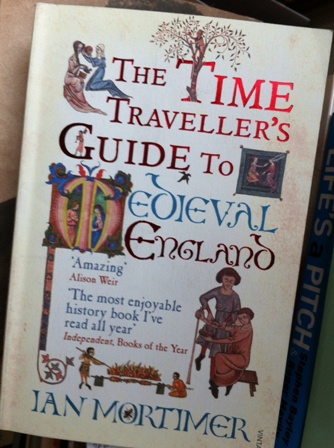
No 20: The Time Traveller’s Guide to Medieval England by Ian Mortimer
What’s it about?
The subtitle of this book is A Handbook for Visitors to the Fourteenth Century and one could argue that this conveys the premise of this excellent work rather better than the main title. This is a travel guide for people who would like to know what it would be like to visit England in the mid-1300s. It is a Lonely Planet guide with a ticket to the Tardis, offering sound guidance and advice on subjects such as the landscape and the people, what to wear and where to stay, what to eat and where to look for a meal. Chapters on health and hygiene, the law and local customs are particularly interesting as they may help you stay alive long enough to make the return journey to the 21st century.
What’s it got to do with leisure?
Think of medieval history and certain images will pop into your mind: perhaps knights in armour and improbably crenellated castles, or monks in dark tunics among a plague-ridden populace. However, whatever our personal perspectives, life for anyone living in the 14th century was about living and all that this entails, whether work and hardship or rest and enjoyment. The Time Traveller’s Guide explores all aspects of medieval life, including the pursuits, games and activities that shape the culture and offer an outlet for any energies that might be left after a hard day’s work, whether you be a vellein, a yeoman or an archbishop.
For the leisure-based reader, The Time Traveller’s Guide is particularly fascinating on the exuberance of life and what the culture of a medieval town or village might comprise. The undeniable and inescapable hardships of medieval life are found to be leavened by dancing and singing, the joust, hunting and falconry, wrestling and baiting, football and tennis, archery, literature and performance. All are explored and set in the context of lives lived with intensity and exuberance.
Why should I read it?
This book should be the starting point for anyone beginning to show an interest in history. It is scholarly and detailed but it wears its expertise lightly. Its account of life in the medieval period is visual, immediate and engaging. It challenges the imagination and grabs the attention of the reader from the first paragraph of the introduction: “Imagine yourself in a dusty London street on a summer morning.” From here it never lightens its grip or loses its way. It puts the reader in the picture and compels them to walk the strange but strangely familiar streets and wonder about how things work and why.
This is a hugely engaging and entertaining work but by placing itself into the realm of what might be termed ‘virtual history’ it is also something of a rarity within historical study. The traditional approach to history focuses on the ‘what’ and the ‘who, with supporting forays into the ‘why’. Here the focus is on the ‘how’ and the ‘what if’; alongside the ‘why’ is the ‘why not?’ It all makes for a very entertaining introduction to the medieval period and a very useful starting point for anyone looking to start or rekindle an interest in the study of history.
the leisure manager’s library
An occasional series offering a guide to leisure-related literature
